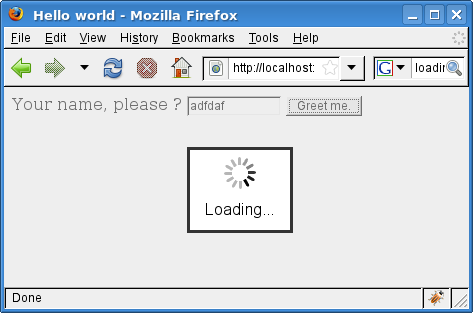Class WOverlayLoadingIndicator
- All Implemented Interfaces:
WLoadingIndicator
public class WOverlayLoadingIndicator extends WContainerWidget implements WLoadingIndicator
This loading indicator uses a gray semi-transparent overlay to darken the window contents, and centers a loading icon (with some text).
Usage example:

The overlay loading indicator
Note: For this loading indicator to render properly in IE, you need to reset the "body" margin to 0. Using the inline stylesheet, this could be done using:
CSS
This widget does not provide styling, and can be styled using inline or external CSS as appropriate.
i18n
The strings used in this class can be translated by overriding the default values for the following localization keys:
- Wt.WOverlayLoadingIndicator.Loading: Loading...
-
Nested Class Summary
Nested classes/interfaces inherited from class eu.webtoolkit.jwt.WContainerWidget
WContainerWidget.OverflowNested classes/interfaces inherited from class eu.webtoolkit.jwt.WObject
WObject.FormData -
Field Summary
Fields inherited from class eu.webtoolkit.jwt.WInteractWidget
dragTouchEndSlot_, dragTouchSlot_ -
Constructor Summary
Constructors Constructor Description WOverlayLoadingIndicator()Construct the loading indicator.WOverlayLoadingIndicator(java.lang.String styleClass)Construct the loading indicator.WOverlayLoadingIndicator(java.lang.String styleClass, java.lang.String backgroundStyleClass)Construct the loading indicator.WOverlayLoadingIndicator(java.lang.String styleClass, java.lang.String backgroundStyleClass, java.lang.String textStyleClass)Construct the loading indicator. -
Method Summary
Modifier and Type Method Description WWidgetgetWidget()Returns the widget that visually represents the indicator.voidsetMessage(java.lang.CharSequence text)Sets the message that you want to be displayed.Methods inherited from class eu.webtoolkit.jwt.WContainerWidget
addWidget, clear, createDomElement, getContentAlignment, getCount, getDomChanges, getIndexOf, getLayout, getPadding, getScrollLeft, getScrollTop, getWidget, insertBefore, insertWidget, isGlobalUnfocussed, isList, isOrderedList, isUnorderedList, parentResized, remove, removeWidget, scrolled, setContentAlignment, setContentAlignment, setFormData, setGlobalUnfocused, setLayout, setLayout, setLayout, setList, setList, setOverflow, setOverflow, setOverflow, setPadding, setPadding, setPaddingMethods inherited from class eu.webtoolkit.jwt.WInteractWidget
clicked, doubleClicked, enterPressed, escapePressed, gestureChanged, gestureEnded, gestureStarted, getMouseOverDelay, isEnabled, keyPressed, keyWentDown, keyWentUp, load, mouseDragged, mouseMoved, mouseWentDown, mouseWentOut, mouseWentOver, mouseWentUp, mouseWheel, propagateSetEnabled, setDraggable, setDraggable, setDraggable, setDraggable, setMouseOverDelay, setPopup, touchEnded, touchMoved, touchStarted, unsetDraggableMethods inherited from class eu.webtoolkit.jwt.WWebWidget
addStyleClass, blurred, callJavaScriptMember, childrenChanged, doJavaScript, enableAjax, escapeText, escapeText, escapeText, escapeText, find, findById, focussed, getAttributeValue, getBaseZIndex, getChildren, getClearSides, getDecorationStyle, getFloatSide, getHeight, getHtmlTagName, getId, getJavaScriptMember, getLineHeight, getMargin, getMaximumHeight, getMaximumWidth, getMinimumHeight, getMinimumWidth, getOffset, getPositionScheme, getScrollVisibilityMargin, getStyleClass, getTabIndex, getToolTip, getVerticalAlignment, getVerticalAlignmentLength, getWidth, hasFocus, hasStyleClass, isCanReceiveFocus, isDisabled, isHidden, isHiddenKeepsGeometry, isInline, isLoaded, isPopup, isRendered, isScrollVisibilityEnabled, isScrollVisible, isSetFirstFocus, isThemeStyleEnabled, isVisible, jsStringLiteral, jsStringLiteral, parentResized, propagateSetVisible, refresh, removeScript, removeStyleClass, render, resize, scrollVisibilityChanged, setAttributeValue, setBaseZIndex, setCanReceiveFocus, setClearSides, setDecorationStyle, setDeferredToolTip, setDisabled, setFloatSide, setFocus, setHidden, setHiddenKeepsGeometry, setHtmlTagName, setId, setInline, setJavaScriptMember, setLineHeight, setLoadLaterWhenInvisible, setMargin, setMaximumSize, setMinimumSize, setOffsets, setPositionScheme, setScrollVisibilityEnabled, setScrollVisibilityMargin, setSelectable, setStyleClass, setTabIndex, setThemeStyleEnabled, setToolTip, setVerticalAlignment, updateSignalConnection, voidEventSignalMethods inherited from class eu.webtoolkit.jwt.WWidget
acceptDrops, acceptDrops, addCssRule, addCssRule, addJSignal, addStyleClass, animateHide, animateShow, boxBorder, boxPadding, createJavaScript, disable, dropEvent, enable, getDropTouch, getJsRef, getParent, hide, htmlText, isExposed, isLayoutSizeAware, layoutSizeChanged, needsRerender, positionAt, positionAt, removeChild, removeStyleClass, render, resize, scheduleRender, scheduleRender, scheduleRender, setClearSides, setDeferredToolTip, setFocus, setHeight, setHidden, setLayoutSizeAware, setMargin, setMargin, setMargin, setMargin, setMargin, setObjectName, setOffsets, setOffsets, setOffsets, setOffsets, setOffsets, setToolTip, setVerticalAlignment, setWidth, show, stopAcceptDrops, toggleStyleClass, toggleStyleClass, trMethods inherited from class eu.webtoolkit.jwt.WObject
addChild, getObjectNameMethods inherited from class java.lang.Object
clone, equals, finalize, getClass, hashCode, notify, notifyAll, toString, wait, wait, wait
-
Constructor Details
-
WOverlayLoadingIndicator
public WOverlayLoadingIndicator(java.lang.String styleClass, java.lang.String backgroundStyleClass, java.lang.String textStyleClass)Construct the loading indicator.- Parameters:
styleClass- the style class for the central boxbackgroundStyleClass- the style class for the "background" part of the indicatortextStyleClass- the style class for the text that is displayedNote: if styleClass is not set, the central box gets the CSS style elements
background: white; border: 3px solid #333333; z-index: 10001; visibility: visible; position: absolute; left: 50%; top: 50%; margin-left: -50px; margin-top: -40px; width: 100px; height: 80px; font-family: arial,sans-serif; text-align: centerNote: if backgroundStyleClass is not set, the background gets the CSS style elements
background: #DDDDDD; height: 100%; width: 100%; top: 0px; left: 0px; z-index: 10000; -moz-background-clip: -moz-initial; -moz-background-origin: -moz-initial; -moz-background-inline-policy: -moz-initial; opacity: 0.5; filter: alpha(opacity=50); -moz-opacity:0.5; position: absolute;
-
WOverlayLoadingIndicator
public WOverlayLoadingIndicator()Construct the loading indicator.Calls
this("", "", "") -
WOverlayLoadingIndicator
public WOverlayLoadingIndicator(java.lang.String styleClass)Construct the loading indicator.Calls
this(styleClass, "", "") -
WOverlayLoadingIndicator
public WOverlayLoadingIndicator(java.lang.String styleClass, java.lang.String backgroundStyleClass)Construct the loading indicator.
-
-
Method Details
-
getWidget
Returns the widget that visually represents the indicator.You should reimplement this method to return a widget that will be shown to indicate that a response is pending. The widget should be positioned using CSS.
The widget will be shown and hidden using
WWidget.show()andWWidget.hide(). If you want to customize this behaviour, you should reimplement theWWidget#setHidden()method. Note thatWWidget.show()andWWidget.hide()are stateless slots, and thus you need to make sure that your implementation comforms to that contract, so that it may be optimized to JavaScript (the server-side implementation will only be called during stateless slot prelearning).Note: The widget will not be added to the
WApplication.getRoot()container.- Specified by:
getWidgetin interfaceWLoadingIndicator
-
setMessage
public void setMessage(java.lang.CharSequence text)Description copied from interface:WLoadingIndicatorSets the message that you want to be displayed.If the indicator is capable of displaying a text message, then you should reimplement this method to allow this message to be modified.
- Specified by:
setMessagein interfaceWLoadingIndicator
-